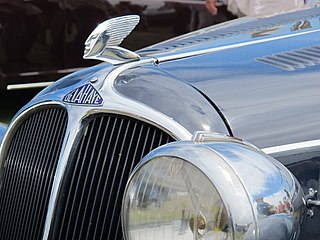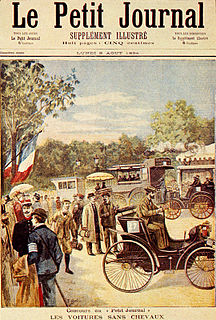
Panhard was a French motor vehicle manufacturer that began as one of the first makers of automobiles. It was a manufacturer of light tactical and military vehicles. Its final incarnation, now owned by Renault Trucks Defense, was formed by the acquisition of Panhard by Auverland in 2005, and then by Renault in 2012. In 2018 Renault Trucks Defense, ACMAT and Panhard combined under a single brand, Arquus.

L'Aster, Aster, Ateliers de Construction Mecanique l'Aster, was a French manufacturer of automobiles and the leading supplier of engines to other manufacturers from the late 1890s until circa 1910/12. Although primarily known as an engine mass manufacturer the company also produced chassis for coach-works and a complete range of components.

The Benz Velo was one of the first cars. Introduced by Karl Benz in 1894 as the followup to the Patent Motorwagen, the Velo is credited, together with the Duryea Motor Wagon, patented in 1895, as one of two first standardized cars. 67 Benz Velos were built in 1894 and 134 in 1895. The early Velo had a 1L 1.5 hp engine and later a 3 hp engine giving a top speed of 12 mph (20 km/h). The Velo was officially introduced by Karl Benz as the Velocipede, and became the world's first large-scale production car. The Velocipede remained in production between 1894 and 1902, with a final count of over 1,200 produced. It was the first car introduced to South Africa and was demonstrated to then President Paul Kruger on 4 January 1897.

De Dion-Bouton was a French automobile manufacturer and railcar manufacturer operating from 1883 to 1953. The company was founded by the Marquis Jules-Albert de Dion, Georges Bouton, and Bouton's brother-in-law Charles Trépardoux.

Delahaye automobile was an automotive manufacturing company founded by Émile Delahaye in 1894, in Tours, France, his home town. His first cars were belt-driven, with single- or twin-cylinder engines mounted at the rear. His Type One was an instant success, and he urgently needed investment capital and a larger manufacturing facility. Both were provided by a new Delahaye owner and fellow racer, George Morane, and his brother-in-law Leon Desmarais, who partnered with Émile in the incorporation of the new automotive company, "Societe Des Automobiles Delahaye", in 1898. All three worked with the foundry workers to assemble the new machines, but middle-aged Émile was not in good health.

The Peugeot 908 HDi FAP is a sports prototype racing car built by the French automobile manufacturer Peugeot to compete in the 24 Hours of Le Mans endurance race, starting in 2007 and eventually winning in 2009. This effort, in development since 2005, was publicly unveiled on 15 June 2005. It first competed against the Audi R10 TDI, becoming the second diesel engined sports car from a major manufacturer, and then against the Audi R15 TDI. This was Peugeot Sport's first Le Mans effort since the end of the Peugeot 905 project in 1993. It won 19 from the 28 races in which it raced between 2007 and 2010.

The Peugeot 202 is a supermini developed and designed by the French car manufacturer Peugeot. Production of the car ran between 1938 and 1942 and then, after a brief production run of 20 in early 1945, restarted in mid-1946. It was sold until 1949, by when it had been replaced by the 203.

The Peugeot 402 is a large family car produced in Sochaux, France from 1935 to 1942 by Peugeot. It was unveiled at the Paris Motor Show in 1935, replacing the Peugeot 401.

The Peugeot Type 5 was a small car by Peugeot, produced from 1893 to 1896. Mechanically, little was changed from the Peugeot Type 3. The engine and most of the mechanical parts were unchanged, but the car was shorter, lighter, and correspondingly made more of its 2 horsepower. However, against larger models from Peugeot, this car did not fare well. A total of 14 were sold.

The Peugeot armoured car was a four-wheeled armoured vehicle based on a commercial Peugeot truck that was quickly developed by the French in 1914 for use during the First World War.

Gustave Adolphe Clément, from 1909 Clément-Bayard, was a French entrepreneur. An orphan who became a blacksmith and a Compagnon du Tour de France, he went on to race and manufacture bicycles, pneumatic tyres, motorcycles, automobiles, aeroplanes and airships.

The Peugeot Type 28 is an early motor vehicle produced between 1899 and 1900 by the French auto-maker Peugeot at their Audincourt plant. Only 8 were produced.

The Peugeot Type 48 is an early motor vehicle produced between 1902 and 1909 by the French auto-maker Peugeot at their Audincourt plant. It was a small and (relatively) inexpensive open bodied four seater.

Albert Lemaître, , was a French sporting motorist and early racing driver. He was the first petrol powered finisher in what is described as 'the world's first competitive motoring event' when he drove his Peugeot Type 7 from Paris to Rouen at 19 km/h (12 mph) in 1894. The Comte de Dion had finished first but his steam-powered vehicle was ineligible for the main prize which was shared between the manufacturers Peugeot and Panhard.

Paris–Rouen, Le Petit Journal Horseless Carriages Contest, was a pioneering city-to-city motoring competition in 1894 which is sometimes described as the world's first competitive motor race.
The Paris–Marseille–Paris race was the first competitive 'city to city' motor race, where the first car across the line was the winner, prior events having selected the winner by various forms of classification and judging. The race was won by Émile Mayade who completed the ten-day, 1,710 km, event over unsurfaced roads in 67 hours driving a Panhard et Levassor.

Auguste Frédéric Doriot was a French motoring pioneer who developed, built and raced cars for Peugeot before founding his own manufacturing company D.F.P. in combination with Ludovic Flandrin and the Parant brothers. In 1891, Doriot and his Peugeot colleague Louis Rigoulot completed the longest trip by a petrol powered vehicle when their self-designed and built Daimler powered Peugeot Type 3 completed 2,100 kilometres from Valentigney to Paris and Brest and back again. They were attached to the first Paris-Brest-Paris bicycle race, but the duo reached Brest one day after the winning cyclist, Charles Terront, finished in Paris, and they then finished six days after him.

Société Parisienne was a French manufacturer of velocipedes, bicycles and tricycles from 1876. They began limited automobile construction in 1894 and regular light car (voiturette) construction in 1898 or 1899, and they ceased operation in 1903. The vehicles, variously known as Parisienne, Victoria Combination, Eureka, l'Eclair, Duc-Spider and Duc-Tonneau, were manufactured by Société Parisienne E. Couturier et Cie of Paris.
Auto racing began in the mid-19th century, and the sport has grown in popularity ever since.


















